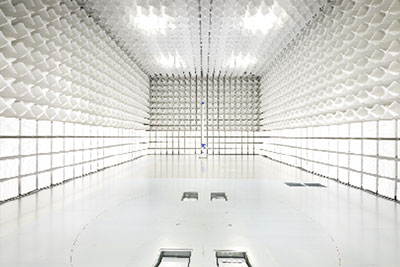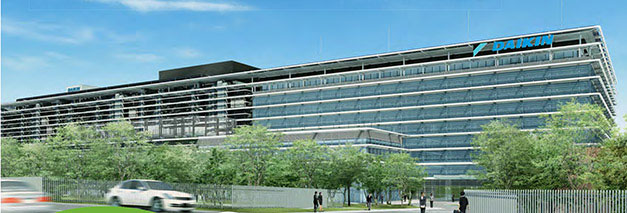Daikin opens €300m technology centre
25th November 2015JAPAN: Daikin has created a core facility for future product developments with a new JPY38bn (€300m) technology centre at its Yodogawa factory in Settsu City, Japan.
The new six-storey, 58,000m² facility will be the core base for Daikin’s future technology developments in air conditioning, inverters, heat pumps, and refrigerants. The building itself is also said to combine a number of Daikin technologies to achieve zero energy.
Engineers that had been dispersed to three Daikin bases in Japan (Sakai, Shiga, and Yodogawa) have been moved to Daikin’s new Technology and Innovation Centre (TIC) where the workforce will number around 700 people.
Daikin says that TIC will actively promote global cooperation with industry, government, and academia and attract people, information, and technology from around the world. In particular, the company is seeking to implement what it calls “collaborative creation” on a global level through alliances and collaborations with various companies, universities, and research organisations possessing distinctive technologies in a different field or industry.
Daikin already collaborates with Kyoto University, Osaka University, and Nara Institute of Science and Technology and conducts joint research and development with home builders, manufacturers of electrical appliances and materials, and architectural firms.

“In the future, we will invite experts to TIC from every field for long-term stays to provide guidance in technology and proposals on strategy for mid- to long-term technology development involving Daikin engineers,” the company says in a statement.
“The speed of progress and change in technology centring on telecommunications and software continues to accelerate,” the company says. Daikin is anticipating this change, enhancing each core technology in the businesses of air conditioning, chemicals, oil hydraulics, defence systems, and electronics, and endeavouring to fuse world-leading technologies that include technologies in telecommunications, advanced materials, processing, sensors, and medical equipment and healthcare.”
To achieve this, a variety of design innovations were incorporated in the TIC office and laboratory areas to promote collaborative creation for engineers to overcome barriers. Also included is a circular auditorium with seating capacity for 250 people, and the incorporation of simultaneous translation booths.
In addition to an air conditioning element platform and a testing room for product base models, TIC is said to be equipped with world-leading laboratory facilities that are necessary for future business development including businesses involving heating and hot water supply, fluorine materials, and global air conditioning.

The problems of electromagnetic noise will be investigated in an electromagnetic semi-anechoic chamber. Daikin says this will enable it to react more quickly to electromagnetic noise regulations across the world, speed development and improve product reliability.
A low temperature, high humidity laboratory test lab maintains a maximum of 90% humidity in an environment that simulates conditions of an outdoor air conditioning unit installed in environments of extreme temperatures ranging from -35 to 60℃ and can confirm resistance to cold of outdoor units exposed to severe freezing and frost formation. Installation conditions are recreated for each global market and improve product reliability.
In addition, the new TIC boasts an artificial climate laboratory where the actual environments where products are used are considered, and tests are conducted by assuming conditions such as the sunlight cast from the window and heat entering from one surface of the room.
There’s also a sleep and metabolic laboratory with the necessary facilities to support actual human living conditions. Daikin says that this will enable experiments corresponding to air environments in the home and human physiology and help verify the creation of new air value such as air providing life vitality and relaxation and air promoting a good night’s sleep.
The TIC building is itself designed to be a model of efficiency. It is aiming for an initial 70% energy reduction and 100% energy savings in the future by updating facilities as a solution model for development and verification of each new energy technology.
Initially, the building incorporates individual control of temperature and humidity by multi-split air conditioners; peak shift by thermal storage and heating by exhaust heat recovery; BEMS; and solar panels with tracking mounts to improve power generation efficiency.
Even in Japan, there have been few instances of actual recorded data for the introduction and use of these energy-saving technologies, and Daikin intends to utilise these results to obtain the highest rank of Platinum under LEED, the US green building certification programme.








